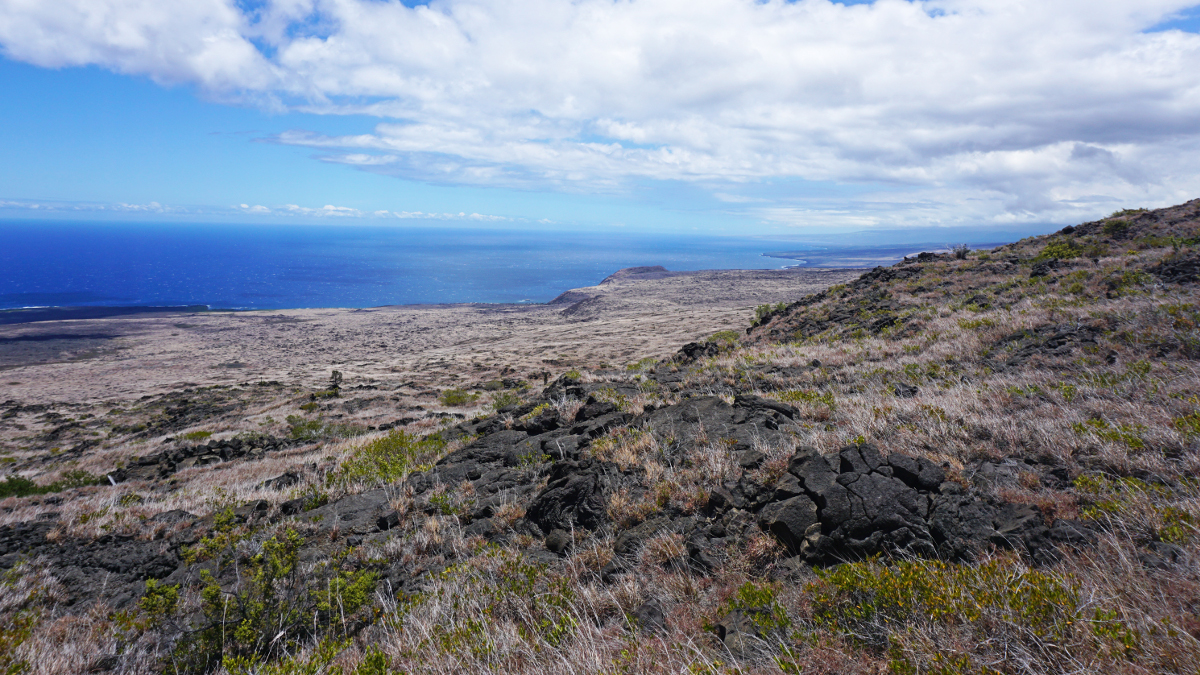(BIVN) – Two hikers were rescued by helicopter Thursday evening after getting lost overnight and running out of water in Hawai‘i Volcanoes National Park.
From the National Park Service:
The two men, ages 82 and 72, are Volcano residents and are experienced hikers, but a late start from the Mau Loa o Mauna Ulu trailhead to Keauhou on Wednesday afternoon did not afford them enough time to reach the Keauhou campsite. The campsite, located on the park’s remote and rugged lava rock coastline, is reached by a rigorous downhill 7.6-mile (12.2 km) hike from the trailhead through the Ka‘ū Desert Wilderness.
The hikers wandered off trail, did not reach the campsite, and bedded down off trail overnight. On Thursday, they found a familiar landmark but due to the rough terrain and lack of water, they were unable to make much distance. By 4 p.m., they called an emergency contact listed on their backcountry permit, who called the park to report them lost.
Hawai‘i Fire Department resources assisted, and the men were found on the rough, hardened ‘a‘ā field above ‘Āpua Point, and flown to safety by Hawai‘i Fire Department’s Chopper One by 5:45 p.m. Both men were mildly dehydrated, and upon evaluation by emergency medical services personnel, it was determined that the men did not require further medical attention.
“We are relieved the hikers were located, and are appreciative of the County of Hawai‘i’s quick response in coming to their assistance by helicopter,” said Hawai‘i Volcanoes National Park Acting Chief Ranger Jack Corrao. “There are valuable lessons to be learned here, and they include allowing enough time to complete your hike, being mindful of weather conditions, and being adequately prepared for emergencies by having enough water. It’s been extremely hot and dry on the coast, and we urge hikers to carry at least three to four quarts of water per person per day,” Corrao said. He also noted that cell phone service is unreliable in many remote areas of the park.
The National Park Service urges hikers to prepare for a trek with these 10 essentials:
- NAVIGATION – Map, compass, and GPS system
Navigation systems are used when planning your route before your trip, and when you need help orienting yourself in your surroundings during your activity. Know how to use a topographical or relief map as well as your compass or GPS unit before going out. - SUN PROTECTION – Sunglasses, sunscreen, and hat
Sun protection is necessary to protect your skin and eyes against harsh UV rays that are responsible for sunburns and skin cancer. Consider using sunglasses, sunscreen, and hats. Sun-protection clothing such as pants and long sleeve shirts can also help minimize your exposure to the sun. - INSULATION – Jacket, hat, gloves, rain shell, and thermal underwear
Nature is unpredictable. Be prepared for sudden changes in weather conditions. Pack an extra layer of clothing that reflects the most extreme conditions you could encounter. - ILLUMINATION – Flashlight, lanterns, and headlamp
Lighting is indispensable in the outdoors where no conventional light sources can be found. Items include flashlights, lanterns, and headlamps. Headlamps are the preferred light source because they are hands-free. Be sure to pack extra batteries. - FIRST-AID SUPPLIES – First Aid Kit
Be prepared for emergencies by packing first-aid supplies with you. Start with a pre-made kit and modify it to fit your trip and your medical needs. Check the expiration date on all items and replace them as needed. Consider including an emergency guide in case you are faced with an unfamiliar medical emergency. - FIRE – Matches, lighter and fire starters
Fire can be an emergency signal and a heat source for cooking and staying warm. Pack matches (preferably waterproof) and fire starters – items that catch fire quickly and sustain a flame (e.g. lighter). Familiarize yourself with the fire use regulations of your park before heading out. Learn more about campfires. - REPAIR KIT AND TOOLS – Duct tape, knife, screwdriver, and scissors
Carry a basic repair kit with you to help repair equipment. The kit should include items such as duct tape, a knife, and scissors. Consider packing a multi-tool, a compact version of many tools that can include a knife, screwdriver, can opener, etc. Be sure to bring any tools specific to your trip and your activity. - NUTRITION – Food
You should always be prepared for the possibility of changes to your trip plans. Pack an extra day’s supply of food, preferably no-cook items that have good nutritional value in order to keep your energy high. Salty and easy to digest snacks (e.g. trail mix, nuts, and granola bars) work well for outdoor activities. - HYDRATION – Water and water treatment supplies
Staying hydrated on your trip is of utmost importance! Physical activity increases your risk of dehydration (loss of water and salts from the body), which can lead to negative health consequences. If you’re active outdoors (hiking, biking, running, swimming, etc.), especially in hot weather, you should drink water often and before you feel thirsty. Prepare your water before you need it and do not allow yourself to become dehydrated. Before heading out on your trip, be sure to identify if there are any bodies of water at your destination that you could collect water from and treat using your water treatment supplies. - EMERGENCY SHELTER – Tent, space blanket, tarp, and bivy
Shelter is one of the most important elements during an emergency survival situation. It can protect you from severe weather conditions and exposure to the elements. A tent, tarp, bivy sack, or emergency space blanket are all light weight options for emergency shelter.


by Big Island Video News2:59 pm
on at
STORY SUMMARY
HAWAIʻI VOLCANOES NATIONAL PARK - Two hikers were rescued by helicopter Thursday evening after getting lost in a remote area of the National Park overnight and running out of water.